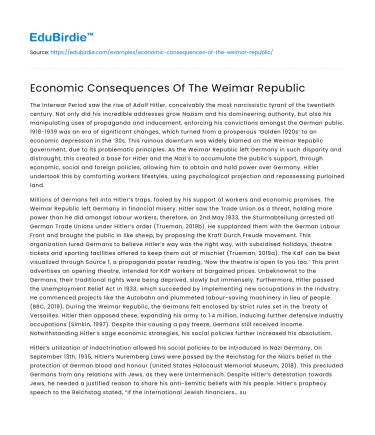The Interwar Period saw the rise of Adolf Hitler, conceivably the most narcissistic tyrant of the twentieth century. Not only did his incredible addresses grow Nazism and his domineering authority, but also his manipulating uses of propaganda and inducement, enforcing his convictions amongst the German public. 1918-1939 was an era of significant changes, which turned from a prosperous ‘Golden 1920s’ to an economic depression in the ’30s. This ruinous downturn was widely blamed on the Weimar Republic government, due to its problematic principles. As the Weimar Republic left Germany in such disparity and distraught, this created a base for Hitler and the Nazi’s to accumulate the public’s support, through economic, social and foreign policies, allowing him to obtain and hold power over Germany. Hitler undertook this by comforting workers lifestyles, using psychological projection and repossessing purloined land.
Millions of Germans fell into Hitler’s traps, fooled by his support of workers and economic promises. The Weimar Republic left Germany in financial misery. Hitler saw the Trade Union as a threat, holding more power than he did amongst labour workers, therefore, on 2nd May 1933, the Sturmabteilung arrested all German Trade Unions under Hitler’s order (Trueman, 2019b). He supplanted them with the German Labour Front and brought the public in like sheep, by proposing the Kraft Durch Freude movement. This organization lured Germans to believe Hitler’s way was the right way, with subsidised holidays, theatre tickets and sporting facilities offered to keep them out of mischief (Trueman, 2019a). The KdF can be best visualized through Source 1, a propaganda poster reading, ‘Now the theatre is open to you too.’ This print advertises an opening theatre, intended for KdF workers at bargained prices. Unbeknownst to the Germans, their traditional rights were being deprived, slowly but immensely. Furthermore, Hitler passed the Unemployment Relief Act in 1933, which succeeded by implementing new occupations in the industry. He commenced projects like the Autobahn and plummeted labour-saving machinery in lieu of people (BBC, 2019). During the Weimar Republic, the Germans felt enclosed by strict rules set in the Treaty of Versailles. Hitler then opposed these, expanding his army to 1.4 million, inducing further defensive industry occupations (Simkin, 1997). Despite this causing a pay freeze, Germans still received income. Notwithstanding Hitler’s sage economic strategies, his social policies further increased his absolutism.
Save your time!
We can take care of your essay
- Proper editing and formatting
- Free revision, title page, and bibliography
- Flexible prices and money-back guarantee
Hitler’s utilization of indoctrination allowed his social policies to be introduced in Nazi Germany. On September 13th, 1935, Hitler’s Nuremberg Laws were passed by the Reichstag for the Nazi’s belief in the protection of German blood and honour (United States Holocaust Memorial Museum, 2018). This precluded Germans from any relations with Jews, as they were Untermensch. Despite Hitler’s detestation towards Jews, he needed a justified reason to share his anti-Semitic beliefs with his people. Hitler’s prophecy speech to the Reichstag stated, “If the international Jewish financiers… succeed in plunging the nations once more into a world war, then the result will not be the Bolshevisation of the earth…but the annihilation of the Jewish race in Europe!” (1939). His words referred directly to the Jews, blaming the loss of World War One and Germany’s economic decay on them, as the majority of financial institutions were Jewish owned (HistoryontheNet, 2016b). As the Germans suffered from hyperinflation and economic matters during the Weimar Republic, anyone allegedly responsible was considered abhorrent. Whilst Hitler’s social policies alienated the Jews, his foreign policies allowed Germany to show exceeding predominance over its neighbours.
Germany’s regrowth emerged after they repossessed their land, confiscated in the Treaty of Versailles. Beforehand, the Weimar Republic complied with all rules set in the Treaty of Versailles, such as demilitarizing zones and surrendering territory (Alpha History, 2018). The Germans saw this as Dolchstosslegende. Germany’s extreme weakness due to the Versailles Treaty and the Weimar Republic meant that if one undermined the enforced principles, they would be endorsed by the German public. The 1935 Saar Plebiscite vote was actioned to reunify the lebensraum Saar region with Germany (Cocco, 2014). Source 2 exhibits a Saar status referendum featured in a newspaper in 1935. It stated that 80% of all voters in the petition were supportive of the Nazi’s repossessing the Saar Basin. Hitler was able to convince the public in his favour, as the reclamation would open up industries and occupations, allowing the exportation of resources and production of goods (BBC, 2019). Moreover, the 1936 remilitarization of the Rhineland was a standout amongst Hitler’s perilous plans. With support from his people, Hitler marched 32,000 armed troops into the Rhineland, which was ordered to be permanently demilitarized in the Treaty of Versailles. The Germans favoured this idea as they felt more secure in the event of an attack. Hitler stated, “The forty-eight hours after the march into the Rhineland were the most nerve-racking in my life. If the French had then marched into the Rhineland we would have had to withdraw...” (1937). Unanticipatedly, the French and British had no objections to this as they dreaded another war and were managing other crises’ (HistoryontheNet, 2016a). Both these movements allowed Hitler’s pursuit of becoming a tyrannical leader one step closer.
The repercussions of the Weimar Republic cemented a national leadership position, in redeveloping Germany into a superior nation. Hitler knew he was the one, implementing his economic, social and foreign policies to outshine other nations, retribute from World War One and chiefly, please the German public. His ingenious actions left him with an unforgettable mark in world history.






 Stuck on your essay?
Stuck on your essay?

